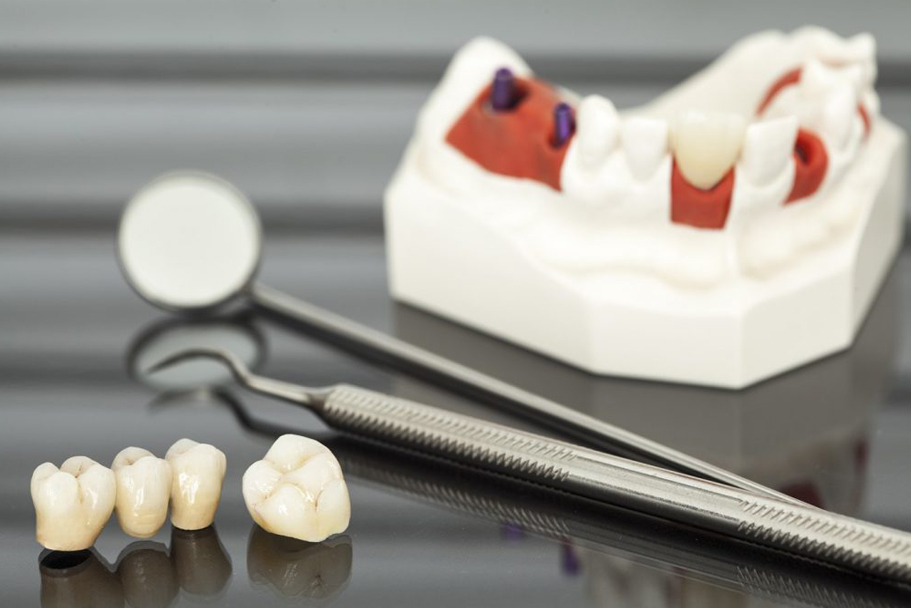CAPS AND BRIDGES
Caps and bridges, often referred to as dental crowns and fixed dental bridges, represent crucial pillars of modern restorative dentistry. These versatile and reliable solutions play a pivotal role in restoring damaged or missing teeth, ensuring both function and aesthetics are seamlessly restored. Dental crowns, also known as caps, provide a robust protective covering for weakened or compromised teeth, preserving their structural integrity and appearance. On the other hand, fixed dental bridges bridge the gap left by missing teeth, anchoring securely to adjacent teeth to restore a complete and functional smile. At our clinics, we will explore the world of caps and bridges, uncovering their various applications, materials, and benefits, ultimately empowering you with the knowledge to make informed decisions about your dental health and smile restoration needs.

Dental Crowns:
Dental crowns, also known as caps, are custom-made covers that fit over damaged or decayed teeth to restore their shape, size, strength, and appearance. They are typically made of materials like porcelain, ceramic, metal, or a combination of these. Here are the steps involved in getting a dental crown:
- Consultation and Examination:The process begins with a consultation with the dentist. They will conduct a thorough examination of the affected tooth to assess whether a crown is necessary.
- Tooth Preparation:The dentist administers local anesthesia to numb the area around the tooth. Then, they remove any decay or damage and shape the tooth to accommodate the crown.
- Impression Taking:An impression of the prepared tooth is made using dental putty or digital scanning technology. This impression serves as a mold for the custom-made crown.
- Temporary Crown (if necessary):In some cases, a temporary crown may be placed over the prepared tooth while the permanent crown is being fabricated in a dental laboratory. This protects the tooth in the meantime.
- Crown Fabrication:The impression is sent to a dental lab, where skilled technicians use it to create the final crown. This process typically takes a few weeks.
- Crown Placement:Once the permanent crown is ready, the patient returns for its placement. The temporary crown (if used) is removed, and the permanent crown is carefully fitted over the prepared tooth.
- Bite Adjustment:The dentist checks the patient's bite to ensure that the crown aligns properly with the surrounding teeth. Adjustments are made if necessary.
- Crown Bonding:Once the fit is satisfactory, the crown is bonded onto the tooth using a strong dental adhesive.
- Dental Bridges:Dental bridges are prosthetic devices used to replace one or more missing teeth. They consist of artificial teeth (pontics) anchored to adjacent natural teeth or dental implants. Here are the steps involved in getting a dental bridge:
- Consultation and Examination:The dentist evaluates the patient's oral health, including the condition of the surrounding teeth and gums, to determine if a bridge is the appropriate treatment.
- Tooth Preparation (for Traditional Bridges):If the patient is getting a traditional bridge, the adjacent teeth (abutment teeth) are prepared by removing a portion of their enamel to accommodate the bridge crowns.
- Impression Taking:Similar to crowns, impressions of the prepared teeth and the surrounding area are taken to create a mold for the bridge.
- Temporary Bridge (if necessary):A temporary bridge may be placed to protect the prepared teeth while the permanent bridge is being fabricated.
- Bridge Fabrication:The impressions are sent to a dental lab, where technicians create the custom bridge. This process can take a few weeks.
- Bridge Placement:Once the permanent bridge is ready, the patient returns for its placement. The temporary bridge is removed, and the permanent bridge is carefully fitted and bonded in place.
- Bite Adjustment:The dentist ensures that the bite is aligned properly with the new bridge. Adjustments are made if needed.
- Final Checks:The dentist evaluates the appearance and function of the bridge to ensure it meets the patient's needs and expectations.
Both dental crowns and bridges are effective solutions for restoring damaged or missing teeth, and they play a significant role in improving oral health and enhancing the appearance of the smile. It's essential to consult with a qualified dentist to determine the most appropriate treatment plan.
